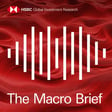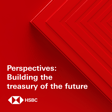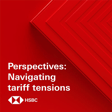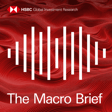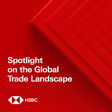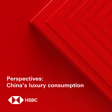Become a Creator today!Start creating today - Share your story with the world!
Start for free
00:00:00
00:00:01

The Macro Viewpoint - ECB hikes, FX drivers, trade challenges
We assess the outlook for Europe’s monetary policy following the ECB’s latest rate hike, consider what’s next for the EUR and USD, and look at what to expect after the global trade boom. Disclaimer. To stay connected and to access free to view reports and videos from HSBC Global Research click here
Hosted on Acast. See acast.com/privacy for more information.
Transcript
Introduction to HSBC Global Viewpoint
00:00:02
Speaker
Welcome to HSBC Global Viewpoint, the podcast series that brings together business leaders and industry experts to explore the latest global insights, trends, and opportunities.
00:00:13
Speaker
Make sure you're subscribed to stay up to date with new episodes.
00:00:16
Speaker
Thanks for listening, and now onto today's show.
Assessing Europe's Monetary Policy Outlook
00:00:24
Speaker
You're listening to the HSBC Global Research Macro Viewpoint, our weekly review of the key reports from our economists and strategists across the globe.
00:00:32
Speaker
Coming up this week, we assess the outlook for Europe's monetary policy following the European Central Bank's latest rate hike.
00:00:41
Speaker
In the currency markets, we consider the prospects for the euro and the dollar.
00:00:45
Speaker
And we look at why the world continues to face trade challenges, despite supply chain pressures easing.
00:00:53
Speaker
This podcast was recorded on Thursday, the 27th of October, 2022.
00:00:57
Speaker
Our full disclosures and disclaimers can be found in the link attached to this podcast.
00:01:03
Speaker
Hello, I'm Piers Butler.
00:01:05
Speaker
And I'm Aline Van Dyne.
ECB Rate Hike and Market Interpretation
00:01:07
Speaker
We begin this week in Europe, where the ECB is continuing to tighten monetary policy, having just concluded its October meeting with another hefty rate rise.
00:01:17
Speaker
Let's get the details from Fabio Balboni, senior European economist.
00:01:22
Speaker
So Fabio, what did the ECB do?
00:01:25
Speaker
Well, first of all, the ECB did increase all rates by 75 basis point.
00:01:30
Speaker
That's the second consecutive 75 basis point rate rise.
00:01:33
Speaker
So another oversized rate rise by the ECB, taking the depo rates to one and a half percent and the main rate to 2%.
00:01:41
Speaker
So that was as expected in line with our expectation as well.
00:01:45
Speaker
Of course, we've seen some central banks starting to take down
00:01:48
Speaker
the foot off the accelerator in terms of rate rises recently, but for the ECB, given the delayed start in terms of the rate hiking cycle and with inflation almost a double digit, a 9.9% in September, really continuing with those large rate rises seemed widely expected.
00:02:08
Speaker
Fabio, the market seemed to respond by interpreting this as somewhat dovish.
00:02:13
Speaker
Is this indeed a dovish pivot in your view?
00:02:16
Speaker
Well, indeed, there were some dovish elements today, and we wouldn't say that it was as far as a dovish pivot.
00:02:23
Speaker
But for instance, in the initial statement, the ECB took off the intention to do
00:02:29
Speaker
do several more rate rises.
00:02:31
Speaker
They did say they want to increase rates further, but the sentence saying there will be several further rate rises has been dropped.
00:02:41
Speaker
Christine Lagarde did reiterate that the intention is to continue to increase rates until when inflation is not back at 2% in the medium term.
00:02:48
Speaker
So clearly, we are still quite a long way off from there.
00:02:51
Speaker
But they also said, however, which we think is interesting, that rather than simply looking at the current inflation outturn, the ECB will also be taking into consideration the implication for inflation of a possible recession.
00:03:05
Speaker
So that's a bit of a change in language.
00:03:07
Speaker
So far, the ECB didn't see in their central case a recession, unlike us, which we think a recession is coming in the eurozone.
00:03:15
Speaker
And they also said that they would take into consideration the impact
00:03:19
Speaker
of the policy action taken so far on inflation going forward.
00:03:24
Speaker
So certainly it does seem that relatively to the very hawkish consensus that we have seen so far in the ECB, within the ECB, as the recession gets closer,
00:03:36
Speaker
some of the doves within the governing council are starting to find their voice again.
00:03:41
Speaker
So to that aspect, yes, it can be seen as a bit of a dovish twist.
00:03:45
Speaker
And it does chime with our view that the ACB will keep raising rates in December and February, but then they will pause when the recession starts to bite.
00:03:54
Speaker
Any other policy measures of note?
Changes to TLTROs and QE Tightening
00:03:58
Speaker
Well, very briefly, there were other policy measures announced.
00:04:01
Speaker
The most notable was a change of the terms of the targeted longer term refinancing operation, the TLTROs.
00:04:10
Speaker
And these are cheap loans provided to the banks.
00:04:13
Speaker
So the ECB made those loans less generous, effectively taking off a lot of the juice for the banks from the 23rd of November.
00:04:23
Speaker
The terms will be changed.
00:04:24
Speaker
And the expectation is that as a result of that, more banks will repay early.
00:04:30
Speaker
some of those loans, and that will help shrinking the balance sheet.
00:04:35
Speaker
We do not think, however, it will solve some of the problems that we have seen in terms of collateral squeeze or shortage of short-end bonds, for instance.
00:04:45
Speaker
So we still think that possible further measure might be needed to alleviate some of those pressures.
00:04:51
Speaker
And finally, which is potentially a good news, the ACB did not discuss a possible quantitative tax
00:04:58
Speaker
tightening yet.
00:04:59
Speaker
So there's been some noise hinting to possible discussion already starting at this meeting.
00:05:05
Speaker
However, Christine Lagarde, the president of the ACB has been very clear.
00:05:08
Speaker
The intention is to start this discussion at the December meeting.
00:05:13
Speaker
So QT is very much on the agenda.
00:05:16
Speaker
It seems likely that it will start at some point next year.
00:05:19
Speaker
Of course, it will be a gradual start, but it could have major implication, particularly for some of the peripheral sovereign bond markets and most notably Italy, given its high debt and high deficit, which means a lot more of sovereign bond issuance will have to be absorbed by the market.
00:05:38
Speaker
Fabio, thank you so much.
00:05:40
Speaker
Thank you very much.
Challenges for the Euro
00:05:43
Speaker
Let's move on to developments in the currency markets now.
00:05:46
Speaker
We're joined by Dominic Bunning, head of European FX Research, to look at what that ECB meeting means for the euro.
00:05:53
Speaker
And ahead of the November Fed meeting, Dom has also been looking at the prospects for the dollar.
00:05:57
Speaker
He joins me now.
00:05:58
Speaker
So, Dom, a big hike from the ECB.
00:06:01
Speaker
Is that a positive for the euro?
00:06:03
Speaker
Thanks, Piers.
00:06:04
Speaker
Look, in our view, it's not really that positive for the euro, firstly, because that 75 basis point hike was fully expected by the market, fully priced in.
00:06:13
Speaker
And what really we think is going to matter is what happens going forward.
00:06:18
Speaker
How much is the ECB going to be able to maintain that hawkishness in the months ahead?
00:06:24
Speaker
And we're somewhat sceptical as to whether they will be able to keep that hawkish momentum, given that the economic story has deteriorated so much.
00:06:34
Speaker
So from our perspective, it's actually going to be harder and harder for the euro to maintain any gains.
00:06:39
Speaker
And actually, in the aftermath of the meeting, you have seen the euro sell off a little bit already.
00:06:43
Speaker
And that really lines up with our way of thinking that the euro is going to struggle to get much upside momentum from here.
00:06:50
Speaker
So what factors are going to influence the euro going forward?
00:06:53
Speaker
So firstly, on that cyclical perspective, you know, the degree to which the ECB can deliver those rate hikes, but also the degree it can deliver them without negative economic consequences.
00:07:03
Speaker
And that obviously is a very, very tricky thing for the ECB to achieve.
00:07:07
Speaker
So that cyclical story, I think, is still somewhat important.
00:07:10
Speaker
But.
00:07:11
Speaker
Behind that, there's also a structural story going on.
00:07:14
Speaker
And we've spoken about this for Sterling in the past.
00:07:16
Speaker
But what you've seen in Europe in the last year or so is a big deterioration in some of the structural factors, particularly the external balances.
00:07:25
Speaker
So the current account has shifted into deficit that puts more reliance on short term capital inflows.
00:07:31
Speaker
And ultimately, in our view, it does require a slightly lower valuation for euro in order to sort of start to see things rebalance.
00:07:38
Speaker
So there's a cyclical negative and a structural negative.
00:07:41
Speaker
Both of those things playing out against each other should drive euro a bit lower in our view.
00:07:45
Speaker
So let's look at the US
Market Speculations on Fed Pivot
00:07:47
Speaker
now.
00:07:47
Speaker
The Federal Reserve meets next week.
00:07:50
Speaker
How has the dollar been performing ahead of that?
00:07:52
Speaker
The dollar's been struggling, to be honest, really because people are focusing on the possibility of a Fed pivot, as it's become known.
00:08:01
Speaker
So this idea that the Fed is going to sort of stop hiking rates and that's going to cause the dollar to weaken.
00:08:06
Speaker
So that's been part of the theme for the last few weeks or so.
00:08:10
Speaker
But we've actually seen this play out a few times this year.
00:08:13
Speaker
We've had a number of occasions where
00:08:15
Speaker
There's been an expectation of a dovish shift by the Fed, and it just hasn't occurred because the reality is inflation pressures are still very strong in the US.
00:08:23
Speaker
The growth story is still more resilient in the US compared to the rest of the world.
00:08:28
Speaker
And so we're really not buying into that idea that the Fed is going to pivot that quickly.
00:08:33
Speaker
And if we're not really buying into the idea that the dollar needs to weaken dramatically.
00:08:36
Speaker
And so that's really how we've been thinking about it for some time.
00:08:40
Speaker
So I know you see the comments in the market.
00:08:42
Speaker
It's tempting to try and forecast a peak in the dollar.
00:08:45
Speaker
But are you saying it's a little bit early to be engaging in that kind of thinking?
00:08:48
Speaker
Yeah, absolutely.
00:08:49
Speaker
We think it's a bit early to call the peak.
00:08:52
Speaker
Really, what we've been looking at for some time is three broad drivers for the dollar.
00:08:56
Speaker
One is the global growth story.
00:08:57
Speaker
Two is the risk appetite story.
00:08:59
Speaker
And three is the relative yield and the relative growth story.
00:09:03
Speaker
Those three forces are becoming a bit less potent.
00:09:05
Speaker
You know, global growth is still slowing, but it's not slowing as much.
00:09:09
Speaker
Risk appetite is still relatively weak, but maybe not as much as before.
00:09:13
Speaker
And the relative story, again, is still in the dollar's favour, but maybe not by as much as it was previously.
00:09:18
Speaker
So,
00:09:19
Speaker
You know, that all suggests that the dollar won't make as big a gains as we've seen this year and that we are getting closer to the peak.
00:09:25
Speaker
But we don't think we're there yet.
00:09:26
Speaker
We think there's probably another round of dollar strength to come into the end of the year and maybe even insert to Q1 next year.
00:09:33
Speaker
But until those those three factors start to shift more dramatically, it is hard to call the end of the dollar rally at the moment.
00:09:40
Speaker
Very clear.
00:09:40
Speaker
Don, thanks for your time.
00:09:42
Speaker
Thanks very much.
00:09:46
Speaker
I'm Harold van der Linde.
00:09:47
Speaker
And I'm Fred Newman.
00:09:48
Speaker
And you can find us under the banyan tree.
00:09:50
Speaker
Join us weekly on our new podcast where we bring Asian markets and macroeconomics into context with special insight from our regional experts here at HSBC Global Research.
00:10:01
Speaker
Search for HSBC Global Viewpoint on Apple Podcasts or Spotify or join us via the HSBC Global Banking and Markets page on LinkedIn.
00:10:10
Speaker
Enjoy the rest of your podcast and we'll see you under the banyan tree.
Easing Global Supply Chain Pressures
00:10:16
Speaker
We wrap up this week's podcast with a look at global trade, where despite easing supply chain pressures and freight rates, there are still plenty of risks on the horizon.
00:10:28
Speaker
Shanela Rajanayagam, trade economist, is here to tell us more.
00:10:33
Speaker
So Shanela, let's start with the good news.
00:10:35
Speaker
It looks like global supply chain pressures are easing.
00:10:39
Speaker
That's right.
00:10:40
Speaker
So it does seem as though some of those pandemic related supply chain pressures are starting to improve.
00:10:46
Speaker
For example, one index of global supply chain pressures is now at a 22 month low.
00:10:52
Speaker
Container freight rates also continue to fall.
00:10:55
Speaker
They're currently around 70% below their pandemic peak.
00:11:00
Speaker
And based on our forecast, they could actually reach 2019 levels by the beginning of next year.
00:11:06
Speaker
So there's certainly some good news for exporters and importers, a combination of the easing pandemic related pressures, but also a little bit of the story of the downturn in consumer demand as well.
00:11:19
Speaker
Despite that, geopolitics is still causing a lot of disruption.
00:11:22
Speaker
What are you seeing there?
Impact of Ukraine War on Trade
00:11:24
Speaker
That's right.
00:11:25
Speaker
So we are still seeing a lot of disruption from the war in Ukraine impacting energy and food trade.
00:11:32
Speaker
On the food trade side, grains exports have started to flow from Ukrainian ports.
00:11:37
Speaker
Over six million tonnes have been exported since the beginning of August.
00:11:42
Speaker
However, there is a risk that the Russia Ukraine grains deal could not be renewed next month.
00:11:49
Speaker
particularly if Russia decides to walk away from the deal or imposes additional conditions.
00:11:55
Speaker
Similarly on the energy trade side, EU gas storage levels are pretty good at the moment, currently over 93% full, and there is some evidence of households and industry actually paring back their energy consumption.
00:12:11
Speaker
But given around 25% of the EU's net domestic energy use is used to produce exports, there is certainly a risk that either potential energy blackouts or demand reduction could lead key manufacturing plants to idle some of their production this winter, and that could have repercussions for global supply chains.
00:12:33
Speaker
And are there any other trade disruptions that businesses should be aware of?
00:12:37
Speaker
So I think there are some disruptions that could be associated with potentially escalating US-China trade tensions.
00:12:46
Speaker
So, for example, the US recently imposed sweeping new export controls on a range of chips exports to China.
00:12:54
Speaker
and that certainly risks exacerbating existing trade tensions, but could also have implications for US exporters given that they send around 20% of their chips exports directly to the mainland.
00:13:10
Speaker
And so certainly it's not just disruption in Europe at the moment, there are pockets of potential geopolitical tensions in other parts of the world as well.
00:13:20
Speaker
And finally, you've also looked at how supply chains have evolved over the past two decades.
Shifts in Asian Trade Dominance
00:13:27
Speaker
What have you found?
00:13:28
Speaker
That's right.
00:13:28
Speaker
So we've taken a bit of a look at how key supply chains have shifted over the past 20 years.
00:13:36
Speaker
And what you really see across the board is the rise of trade in Asia, but also the rise of Asian suppliers exporting to other markets further afield.
00:13:49
Speaker
To give you one example,
00:13:51
Speaker
Mainland China was involved in about three of the top 25 electronics export corridors in 2000, but that had increased by around five fold by 2021.
00:14:03
Speaker
And more recently, you have also seen China lose a bit of market share to the likes of Vietnam, Cambodia,
00:14:10
Speaker
in certain consumer goods as those US-China trade tensions did escalate.
00:14:15
Speaker
So certainly looking ahead, we do expect there to be some beneficiaries from ongoing supply chain rejigging.
00:14:23
Speaker
For example, you have the likes of Vietnam, Cambodia, Bangladesh, all expected to see export growth of over 7% in the coming five years on average.
00:14:34
Speaker
Shanela, thanks very much.
00:14:36
Speaker
Thank you.
00:14:39
Speaker
So that's all from us this week.
00:14:40
Speaker
Thank you to our guests, Fabio Balboni, Dominic Bunning, and Shanela Rajanagam.
00:14:45
Speaker
From all of us here on the team, thanks for listening.
00:14:48
Speaker
We'll be back again next week.
00:15:08
Speaker
Thank you for joining us at HSBC Global Viewpoint.
00:15:11
Speaker
We hope you enjoyed the discussion.
00:15:13
Speaker
Make sure you're subscribed to stay up to date with new episodes.
